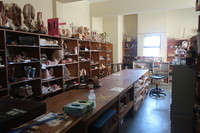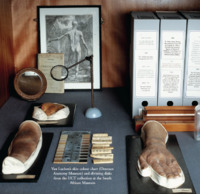Items
Site
The Medicine Chest
keywords is exactly
chart
-

The workshop
"Held in the Department of Human Biology in the Division of Clinical Anatomy and Biological Anthropology, this collection consists of prepared specimens – both bottled and plastinated, anatomical models – and a skeletal repository used for research purposes. The materials are kept in three separate rooms, with the anatomical models in one, the prepared and plastinated specimens in another and the skeleton repository in its own room behind locked doors, viewable by appointment only. The room housing the anatomical models functioned as a workshop when modelmaking was still offered to first year medical students as an elective course: its walls are lined with shelves that display models made from materials ranging from papier-mâché to modern silicon copies and are taxonomised according to their anatomical representations, such as ‘the eye’, ‘head & neck’, ‘dentistry’, ‘embryology’, ‘lungs’ and ‘cardiovascular system’, to name a few. The models represent each anatomical section and are brightly coloured to differentiate the different parts of the human body and aid in identification. Many of the models can be dismantled into separate pieces and, like a puzzle, be reassembled into their original shapes. Interspersed with these models are rolled-up charts depicting organs, bodily systems and anatomical sections of the body in two-dimensional form, as well as old student modelling projects. A selection of animal skeletons is displayed on the far side of the room, and a shelf with a few anatomical specimens in formaldehyde is across from it" (Liebenberg 2021: 121 - 122). -

Page 79 of the Curiosity CLXXV catalogue.
"Created by Felix von Luschan, an Austrian doctor, anthropologist, explorer, archaeologist and ethnographer in the early 20th century, the chart, known as the Von Luschan chromatic scale (...) was used to classify skin colour and featured as a tool in race studies and anthropometry of the time. Forgotten by its current department staff and students, its presence draws attention to the role of medicine and science in the apartheid agenda and to the larger racist scientific practices of measuring and classifying human physical differences in the 19th and 20th centuries to produce a ‘typology of race’ (Sturken & Cartwright 2018: 351–352). To support such theories, object collections in scientific university departments worldwide also featured collections of human remains; tools for measuring the size and shape of skulls; and charts detailing various physiognomic features (Sturken & Cartwright 2018: 351 – 352)" (Liebenberg 2021: 122 - 125).


